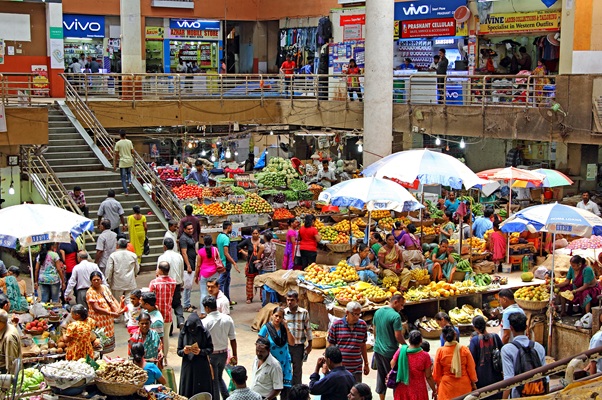.png)

Rajesh Mahapatra, ex-Editor of PTI, has deep experience in political and economic journalism, shaping media coverage of key events.
August 19, 2025 at 6:22 PM IST
Come this October, Prime Minister Narendra Modi promises a Diwali bonanza for Indian consumers with major reforms in the Goods and Services Tax. Changes that would ostensibly make tax assessment and collection simpler and less burdensome. The plan, among other things, would involve reduced duties on a wide range of goods and services and pruning the number of tax slabs.
The promise, made in his Independence Day address to the nation on Friday, has since cheered the consumer and boosted market sentiments — Sensex and Nifty put up a strong show in Monday’s trade.
No doubt the proposed GST reforms are overdue and, if implemented, would go a long way toward addressing many pain points that currently clutter the GST regime. Yet, whether consumption gets a meaningful boost and growth accelerates is far from assured.
Mixed Evidence
While reducing indirect taxes can indeed spur consumption, such a positive outcome will hinge on multiple factors: how much of the cut is actually passed onto consumers; whether the cut is temporary and salient; and if the cuts are broad-based or are confined to select sectors.
Put differently, under what conditions can a tax cut necessarily spur consumption?
Studies unequivocally point out that indirect tax cuts only work when companies and corporations are willing to pass the benefits onto their consumers. Often, they don’t.
A recent IMF Working Paper on VAT reforms across 17 Eurozone countries found that passthrough is almost 100% for the standard rate, but could drop to as low as 30% when tax slabs are lowered. Passthroughs are also higher for durables than non-durables, and weakest in cases of reclassification.
Applied to India, the most impact would come if the government lowers the 18% slab, which covers most goods and services and accounts for 65% of GST earnings. Available indications suggest the 18% category will remain largely unchanged, except for some items such as life and health insurance.
The prime minister, in his speech, did not elaborate on the government’s plan, but finance ministry officials have reportedly said that it involves reducing the number of tax slabs to three — 5%, 18% and 40%. This excludes the zero rate.
Excluding the zero rate, there are currently four slabs — 5%, 12%, 18% and 28%.
Most goods and services that currently attract 12% tax will likely move to the 5% slab, while some goods and services will remain under the 5% slab. It is also likely that items of essential consumption may move to zero rate. FMCG goods typically fall into this segment.
Similarly, several goods and services such as cement, air conditioners and small cars may move from the 28% tax category to 18%, while some such as tobacco, gaming services that are deemed as sin or luxury consumption would attract a new rate, 40%.
Market Reaction
The stock market’s reaction this Monday perhaps keenly reflected the expectations that the proposed changes in GST may have. The spike in share prices was more pronounced in the case of auto, cement and insurance companies compared to FMCG companies. On the other hand, alcohol and gaming stocks fell sharply.
Equally, should the reductions in rates turn out to be limited to a few sectors or categories of goods and services, the expectations around a significant uptick in consumption demand may not come through.
Even when these tax reductions do become broad-based, as a study by the US-based National Bureau of Economic Research showed, companies with low profit margins are likely to respond asymmetrically.
A similar incidence could be expected here if one goes by the latest quarterly earnings of companies like Hindustan Unilever, Nestle, Britannia and Dabur, and the management commentaries that have followed. Most FMCG companies have been aggressively cutting wage costs and operational expenses to stay profitable in the face of sluggish sales and higher raw material prices. Their ability to pass on any tax cuts at this point do appear limited.
The NBER study also showed that prices respond twice as much to tax increases as to tax reductions. In its attempt to make the proposed GST changes revenue-neutral, if the government moves up some goods in the 12% bracket to 18% or from 28% to 40%, the price increases will be much sharper than the reductions in taxes on some goods from 12% to 5% or from 5% to zero.
Another risk is that although companies may initially respond by reducing prices in response to tax cuts, it could also be the case that they gradually return to the previous price regime in due course, notwithstanding the anti-profiteering laws in place. One study on reduction in VAT in the UK in the aftermath of the 2008 global financial crisis bears this out. There is also anecdotal evidence of similar price reversal in India, when excise duties were cut across the board.
Past Lessons
The global financial crisis triggered by widespread subprime loan defaults in the US and collapse of financial giants like Lehman Brothers led countries around the world to roll out fiscal and monetary bailouts, to keep their economies from plunging into a recession.
India too responded with massive cuts in excise duties alongside a significant loosening of its fiscal purse strings. The move helped buoy the economy for a few quarters, but the bounce turned out to be short lived.
By the end of 2010-11, the economy had slipped into a slow lane, stoking a groundswell of disenchantment with the government of the day. Persistently high inflation had significantly eroded real wages and affected consumer appetite even as the government sought to lower retail prices through duty cuts. On the other hand, fiscal deficit had ballooned to a point where the government’s ability to intervene and reverse the economy’s slide was severely constrained. One could only hope that the present government takes enough care to avoid a repeat of 2008.
That said, there are many imponderables, especially political and bureaucratic, that remain to be overcome before the government can come good on the Prime Minister’s Independence Day promise — to eventually make GST a good and simple tax that helps boost consumption and economic growth.
Challenges and Risks
Much of what has appeared in the media so far, relating to the government’s plan, is based on unconfirmed reports and off-the-record briefings. The Indian bureaucracy is notorious in keeping and making things complicated.
There are already indications that the same category goods would be split into multiple tax slabs. For instance, while tax on automobiles of certain grades may be reduced to 18% from 28%, others will likely see an increase from 28% to 40%. We have already seen the complications that come with such reclassifications. Textile and apparel products are a case in point, not to forget the example of popcorn.
It is imperative that there is more transparency around stakeholder consultations, not only with industry and consumer bodies but also with states and the political class.
It is not clear if the Group of Ministers deliberating on the proposed rate changes have actually reached a consensus. Nor is there clarity about the revenue impact of these changes, whether they have been duly assessed and shared with the states.
A consensus will be hard to come by in the absence of a clear assessment of the revenue implications of such changes and a credible plan to offset any losses that state governments may incur. It is also to be noted that the compensation cess, which proved crucial to getting the States to accept the GST eight years ago, is set to end in March 2026.
Before any major changes in the GST regime, states would like to have clarity on what happens next when the compensation cess goes.
News reports have said the Centre is planning a clean energy cess and a health cess in place of the compensation cess. The proposal faces legal challenges and requires constitutional amendment.
More importantly, there is no official word on it, yet.
On Sunday, two days after making the announcement, Modi said he hopes that “all states will cooperate in the initiatives of the central government.” That’s easier said than done.
An emboldened opposition remains acutely wary of any attempt at centralisation at the expense of federal autonomy. The prime minister’s preemptive announcement of a decision that falls in the purview of the GST Council may have further made things more complicated.




